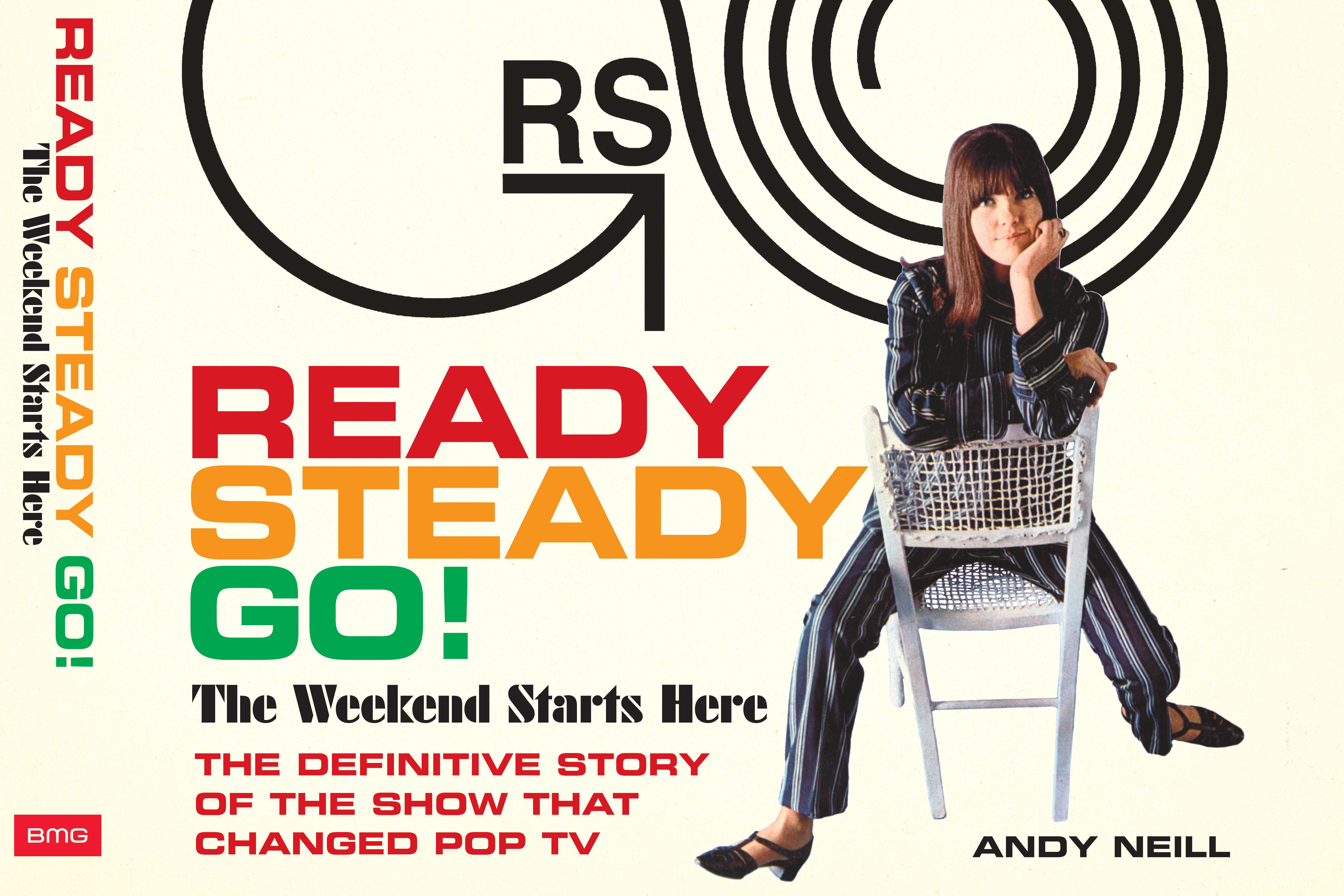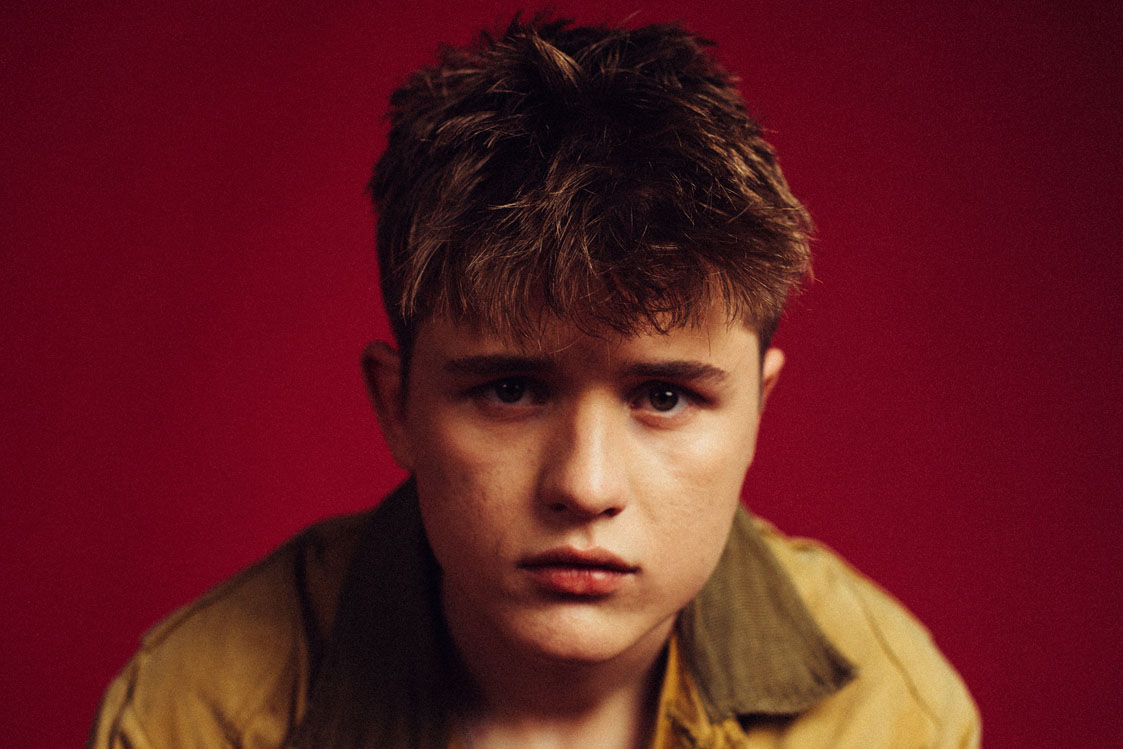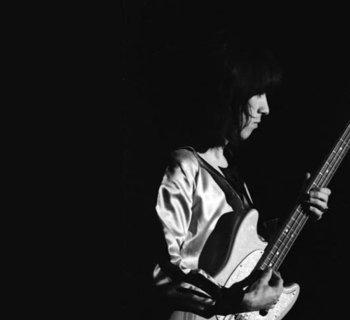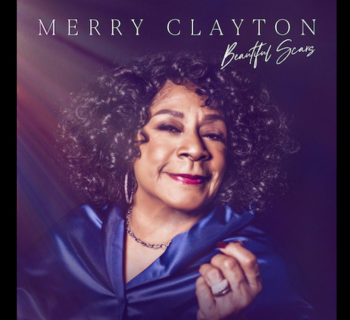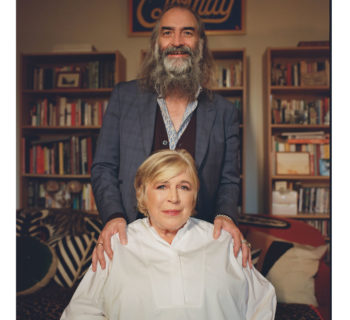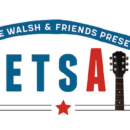In March UK television channel BBC Four broadcast The Story of Ready, Steady, Go!, a documentary on the landmark and influential music show of the sixties. Later this year BMG Books will publish Ready, Steady, Go! The Weekend Starts Here, a comprehensive book on the subject by music writer and historian Andy Neill.
RSG! debuted on British small screens August 9, 1963, with its final broadcast December 23, 1966. The programme was conceived by former journalist Elkan Allan, then head of Light Entertainment at Associated-Rediffusion, the independent television company that controlled London’s weekday programming. Allan hired journalist Francis Hitching as producer and Vicki Wickham as assistant producer to book the talent and look for the best dancers.
RSG! beamed live from Studio 9, in the basement studio in A-R’s headquarters in Kingsway, London, and from 1964 was aired nationally over most of the ITV network. Bill Turner directed the first shows, and a line of directors followed including Robert Fleming, Rollo Gamble, Daphne Shadwell, Michael Lindsay-Hogg, and Peter Croft.
The show’s main presenter was the paternal figure of BBC and Radio Luxembourg DJ, Keith Fordyce, but it was his sidekick, the “Queen of the Mods”, Cathy McGowan, who was the show’s real figurehead. Each week RSG! introduced the new popular music at the time including The Beatles, the Rolling Stones, the Who, Manfred Mann, Dusty Springfield, as well as such then-unknowns as Rod Stewart, Donovan, David Bowie, Marc Bolan and the Jimi Hendrix Experience.
RSG! was an essential television ritual for the newly hormonally-charged British teenager. It epitomized the spirit of youthful optimism that gripped Britain in the mid-sixties, and became a style guide barometer to popular culture trends.
“On Friday nights in England in the mid-sixties, you didn’t do anything until you’d checked out the music, the dances and the fashions on Ready, Steady, Go!, beamed live from a London studio,” stressed author and music journalist Richard Williams in a 2020 email.
“You could see the Stones, the Beatles, the Yardbirds, Lulu, Donovan, Them, Sandie Shaw, the Who or the Animals playing to an audience as cool as they were. Jimi Hendrix and the Beach Boys made their first British TV appearances on RSG! Visiting American soul singers were treated like gods. One entire show was devoted to James Brown, another to Motown artists: the Miracles, the Supremes, Stevie Wonder and Martha and the Vandellas, introduced by Dusty Springfield. The show had the greatest slogan: ‘The weekend starts here!’ And it truly did.”
For many years, Dave Clark from the Dave Clark Five who purchased the rights to the programme in the seventies was restrictive and protective about licensing footage. In 2018 BMG’s management secured rights from Clark.
Ready, Steady, Go! The Weekend Starts Here achieved its place in British television history when, in 2000, the British Film Institute revealed the industry’s favourite British television programmes of all time, as polled in the BFI ‘TV 100’ poll. RSG! was voted into the listings at No. 62 and No. 8 in the Lifestyle/Light Entertainment category.
During 2011, as part of Ray Davies’ Meltdown Festival on London’s South Bank, original show editor Vicki Wickham produced a highly-acclaimed RSG! evening which revisited the original spirit of the show by presenting classic and contemporary performers staged with an evocative backdrop designed by Nicholas Ferguson.
Ready, Steady, Go! has never been documented in full detail before - until now. Thanks to exclusive contributions and unseen photographs and memorabilia, author Andy Neill fully examines Ready, Steady, Go! from quintessential Swinging London accessory to its current iconic status as the most legendary popular music programme of all time.
The book displays recently-penned essays from artists, managers who appeared on the show including Mick Jagger, Andrew Loog Oldham, Pete Townshend, Ray Davies, Chris Stamp, Donovan, Lulu, Barbara Hulanicki and others.
Also featured are Forewords from the show’s original editor Vicki Wickham and acclaimed director, Michael Lindsay-Hogg, exclusive contributions from those directly involved in the show’s production (presenters, directors, dancers, set designers, etc.) as well as illuminating and evocative insight from contemporary viewers whose lives the show touched.
The text is interspersed with hundreds of colour and black & white images – the bulk of them previously unpublished alongside original ephemera and memorabilia (tickets, contracts, letters, etc) as well as illustrations from the groundbreaking set designs and title sequences. Of particular interest is a never-before-published and fully researched complete guide to all 173 episodes, including songs performed and artists’ appearances. (Only 5% of the programme survives. Read and weep at what has been lost!)
“Before I started writing and compiling the book, I was aware of the important part RSG! played in promotion and exposure for new records, dances, and fashions,” underscored Andy Neill in a July 2020 missive to me.
“While undertaking the considerable research involved, I really got a sense of how the show became an important part of the switched-on British teenager’s life, particularly in its peak years 1964 and ’65. Whereas rivals like Thank Your Lucky Stars and Top Of The Pops were static – merely presenting an artist or group on a podium in front of some tacky scenery, RSG! made the performer and the audience equal participants, removing the real or imagined barrier between them.
“The fact that the show wasn’t tied to any stringent formula like TOTP made it that much more adventurous, particularly when RSG! went all-live in April 1965 and moved out of central London to the larger Studio One in Wembley with Michael Lindsay-Hogg as director.
“He was roughly the same age as the musicians and singers and was a fan of the music so he could relate on a much more realistic level. It’s a sad irony that virtually nothing has survived from this crucial part of the show’s development as it really was way ahead in presenting the music as you would hear it in a club or ballroom.
“Groups like the Stones, the Who, the Yardbirds, Manfred Mann, George Fame and singers like Dusty were able to really show what they were about next to the latest Mod fashions and dances. The only music show I can think of that came close to capturing a similar excitement was Shindig! but that was presented like a traditional showbiz-type revue – similar to what Jack Good had already done in England in the late fifties with Oh Boy! – with choreographed dancers and variations of guest acts and musicians together on a huge stage with the audience at a distance. With RSG! it was like you were watching a tightrope walk – with the show going out live, anything could go wrong and it frequently did!”
“I was a dancer on The Beat Room, which was on BBC2 in 1964,” boasted songwriter and music business veteran Kim Fowley in a 2006 conversation. “In 1966, I appeared and sang on Ready, Steady, Go! Otis Redding being booked on Ready, Steady, Go! in September 1966 was a seismic event for the UK and must-see TV.”
“Otis developed an English audience slowly and it began to mushroom with, funnily enough, a song that was not a hit for him in the US - his cover of the Temptations’ ‘My Girl,’ a massive hit in the UK taken off the Otis Blue album,” recollected author Rob Bowman, a Prof. at York University in Canada.
“When Otis played England in the fall of ‘66 the word of mouth on those gigs was extraordinary, and of course he was given a whole show on Ready, Steady, Go! It wasn’t just two songs on Ready, Steady, Go! He did a whole half-hour devoted to him with guests Eric Burdon and Chris Farlowe.
“The impact of that was furthering, if you will, the gospel of Otis Redding among an English audience that was already prone to looking at America for black culture. Going back to trad jazz, the blues revival, the Mod fascination with soul music and eventually mainstream Britain’s fascination with soul music. It’s just a logical extension of that. The Northern soul thing happened a little bit later.”
Like visionary director/producer Jack Good before him (both studied at Oxford), Michael Lindsay-Hogg viewed and lensed rock ‘n’ roll as a dramatic subject. Michael’s first job, at age 16, was serving as an apprentice for John Houseman’s repertory theatre company in Stratford, Connecticut.
“I started out as a child actor and fell in love with the theatre,” Michael told me in a 2019 interview. “The first jobs I had were in Shakespeare on stage. And that’s how it started and I tried very much to bring some of those elements to Ready, Steady, Go!”
“RSG! was a black and white programme,” reinforced Michael Lindsay-Hogg. “A lot of the great comedies and dramas from the forties and fifties were in black and white. In England we had no colour.
“I had no worries from the people above me. Elkan Allen was the creator and always encouraged me to go further. Very helpful. And I think people were stunned by the comparative substance of the rock ‘n’ roll that was on television,” asserted Lindsay-Hogg.
“1963 was a revolution. It was the kids who had been children in World War II. The world was opening up for them. They could have long hair if they wanted too. And it was the discovery of the Pill for pregnancy. And so a whole nation was open for young people and freedom. There was long hair, the Pill and music. The paper was ready to be lit and the match came,” ventured Lindsay-Hogg, who along with John Lennon, Andrew Loog Oldham, Vicki Wickham, Mick Jagger and other bold Brits embodied the confidence of a new London.
“There were new managers in rock ‘n’ roll and around Ready, Steady, Go! Don Arden, Andrew Loog Oldham, and Kit Lambert and Chris Stamp, had been assistant stage managers or involved in acting.”
In my 2004 book, Hollywood Shack Job: Rock Music In Film And On Your Screen. Andrew Loog Oldham recalled. “RSG! represented the time when we were in the business we wanted to be in and RSG! on a Friday night the Green Room was the meeting place of all those similarly blessed. Vicki Wickham booked the show from late 1963 to December 1966. In 1965 Michael Lindsay-Hogg directed it, and tried new techniques like stop action and freeze frame while the band was on camera.
“Suffice to say I still communicate with both of them so that tells you a lot. You were dealing with nice people. None of the people had an agenda. On the show, the visuals propelled the music.”
During a 2016 dialogue Andrew further elaborated, “For one it was obvious that ‘this thing of ours’ was not going to disappear. We had come in following the Twist, Davy Crockett, skiffle, and trad jazz. Skiffle and trad jazz had been very important; they had been the BBC and the establishment’s last chance to control the key to what music we got to hear. You had during 1957-1958 The Six-Five Special; hosted by Pete Murray (God bless him!) and Jo Douglas which invited us all to deck up in jeans and sweaters and be really daring with our shirt collars turned up.
“There were villains, there was mayhem, action and if we had not had pirate radio, I might not have had a hit with Marianne Faithfull's ‘As Tears Go By.’ The BBC would not touch it, they said Marianne could not sing. Mind you, that's what they'd said about Mick Jagger a year earlier when the Rolling Stones failed their BBC live audition. They said ‘The singer cannot sing.’ The BBC was the enemy, a limp-wristed arm of the government trying to keep kids on a rationed musical diet of trad jazz and skiffle.”
“On RSG! Andrew had some ideas about lighting and shots,” offered Lindsay-Hogg. “One evening at the Ad-Lib club I met up with Andrew and we agreed to debut a couple of new songs he was hyped about, including ‘Satisfaction.’
“When the Stones did ‘Paint, It Black,’ we put camera effects on Mick’s face and made it darker and darker,” Lindsay-Hogg emphasized. “We were broadcasting live. It felt dangerous and primitive.
“The cameraman, Bruce Gowers, later did the great video of Queen’s ‘Bohemian Rhapsody,’ which was a very calculated video.
“With RSG! it was about as much about the technique as the performer. In the early RSG! stages, I was always thinking about the performer and somehow marrying the technique to them. If the performer was Mick Jagger and John Lennon you don’t want to get in the way too much.
“Mick is a very bright person and he always has been,” observed Lindsay-Hogg. “And Mick, when he was a younger man, was as keen to know what was going on in the world. He read a lot, or at least he said he did, and was into movies. And Andrew was very much interested in movies and presentation.
“He had been trying to figure out how to make a movie with the Rolling Stones, which Mick and Keith were interested in. Because in those days, even though rock ‘n’ roll was coming to mean what it came to mean, movies were still sort of the art form going back to comedies. So Andrew was
“RSG! went off the air in 1966 when the video became music promotion for the record to be out. 1967 was a difficult year for The Rolling Stones. The set-up drug arrest in Redlands. Touring was becoming a headache.
“And so did we know what was gonna happen to rock ‘n’ roll in the sense that we know that it was ultimately going to blast through the roof? We thought it would.
“When I worked with the Beatles and the Rolling Stones, they were really the first videos which tried to take the form a little further. Like the Beatles playing out in the fields. Following me was a long line of very interesting visual attempts with music.”
Director Michael Lindsay-Hogg directed Rolling Stones’ promotional video clips after 1966: “Jumpin’ Jack Flash’,” “Child Of The Moon” and some of the band’s videos well into the seventies. He helmed the Beatles’ “Hey Jude” and “Revolution” and the group’s film Let It Be.
The heroic efforts of RSG! in 1965 ushering in pop and soul/R&B music to the UK should also be hailed. Vicki Wickham coordinated an hour-long special exclusively devoted to The Sound of Motown and an enthusiastic Dusty Springfield hosted the show. Tamla Motown label recording artists Martha and the Vandellas, the Supremes, the Temptations, Stevie Wonder, the Miracles, and bandleader/conductor Earl Van Dyke.
The relationship forged and cemented between the UK EMI Records distributed Tamla Motown Records products and touring artists were never lost on label founder Berry Gordy, Jr.
In 1995 I interviewed Gordy inside his Bel-Air California mansion for HITS magazine when he was promoting his autobiography To Be Loved. We discussed the love affair the UK has always had with his catalog and the pivotal support of Dave Godin, founder and secretary of the Tamla Motown Appreciation Society, Clive Stone, along with the crucial TV spots on RSG!
“As far as the UK is concerned, it is very, very special to me. Because, actually, we were, I think, more popular there than we were in our own country, you know, for a long time, it seemed. I think the appreciation was different,” volunteered Gordy. “They were not blasé about our music early on. Way back, the pirate ships and all that stuff, they discovered the sound and they were always very important to me when I’d go over there.
“They were just together. I loved their creativity with what they did with our album covers and how they just did it. And when we first went over there with the fan clubs, and the signs and stuff that they had for us. So the UK has always been special for Tamla Motown.
“And when The Beatles Second Album had three of our songs - “Money (That’s What I Want),” “You’ve Really Got A Hold On Me,” and “Please Mr. Postman” - it just indicated to us that they obviously had been listening to our music and they were aware of it, enjoying it and loving it.
“‘Tears Of A Clown’ by Smokey Robinson and The Miracles went to number one in England, I believe, and we hadn’t even released it here... They were on top of everything.
“It’s always been very important to me. England, the Continent, Europe, a very loyal audience but a very deep-feeling people. They certainly are not fickle in their musical tastes. Fans are fans and they are great. I wanted them.”
In November 1974, for Melody Maker, I interviewed Bobby Rogers, a member of the famed Miracles, and Tamla Motown fixture since their inception in 1958, when Bobby joined up with his sister Claudette, Ronnie White, Pete Moore, and William Smokey Robinson.
"I really loved touring with the English groups, back in 1963 and 1964,” exclaimed Rogers in our conversation at a Hollywood recording studio. “We used to tour with the Rolling Stones and people like Georgie Fame. During the breaks from touring, a lot of the groups would ask questions about certain songs on our albums. I remember when we filmed The T.A.M.I. Show in ’64. Mick Jagger would ask me about what I'd thought of the album James Brown Live At The Apollo, which was his favourite LP. He mentioned that he'd like to record a Marvin Gaye song for the next album by the Stones. A month later, 'Hitch Hike' was being played all over Detroit radio.
"Man, those early tours were a trip. Endless hours of bus rides and all these skinny English dudes asking us about the Tamla-Motown sound. I never realized how important or influential we were on groups like the Beatles and Stones. He said his name was George and he was in a group named the Beatles. We used to party with all the groups, and have become good friends. You know, music travels in sort of a cycle. The early days were beautiful. We dug all the people we played with. Back in 1965 my favourite song was 'Get Off My Cloud’.”
"The extremely early Eighties found myself cruelly stranded in Vancouver, British Columbia for nigh on a whole rainy year without my guitars (long story)," reports multi-media maven Gary Pig Gold.
"But immediate emergency employment on the local 7-11's night shift soon enabled rental of one of them new-fangled VCR's with which to fill my few waking hours, along with three – count 'em! – complimentary VHS cassettes thrown in as part of the deal.
"So, buried deep behind all the well-worn Ghost Wars and Starbusters tapes behind said video store's counter I spotted and naturally chose not one, not two, but again, if you're counting, all three of the recently released Ready. Steady, Go! video compilations painstakingly assembled by the one, the only Dave Clark. And while that wily guy, true to form, spliced several stray DC5 clips into the proceedings, there remained enough authentic RSG footage to keep me more than amused and astounded until I'd saved up enough dough to abandon my basement bedsit and head straight back to Surf City.
"Dave's Ready, Steady, Go! Volume One tape, for example, featured the Searchers' pre-Byrd folk-rock template 'What Have They Done To The Rain' alongside a stylishly lip-sync'd 'Baby Please Don't Go' from a fresh-from-Belfast Them, plus Lulu's 'Shout,' Gerry's 'Ferry,' and the savage young Animals hoping for a hit – 'cause we need the bread, y'know' says Eric Burdon – 'Baby Let Me Take You Home.' But it was Georgie Fame's absolutely fab 'Yeh Yeh' which kept the rewind button punched until it was time to load in Volume Two (to watch The Beach Boys mangle their 'When I Grow Up' intro, then the Rolling Stones pantomime 'I Got You Babe' with terrifying results) and finally on to Volume Three (Jerry Lee on his 'High Heel Sneakers' ...say no more).
"Now what impressed me watching this all circa 1983 – and what I can only imagine literally stunned yer typical UK teen two decades prior – was the low-budget yet high-art studio staging of these performances, with each live audience hanging over under sideways and sometimes even down the always frantic, often flummoxed singers and players themselves. Not to mention Michael Lindsay-Hogg's direction and in particular supersonic editing techniques which put even a typical Shindig! episode to slight audio/video shame. Yes, suffice to say this is material which then, and all the way to today, rises completely above and beyond one's standard 'Soundtrack of the Sixties' stuff to brilliantly reflect just what that golden age of socio-musical youth-quaking in its natural habitat was strictly about: It was hard. It was loud. And it was fast. And the Weekend... it was only the Start!"
For writer, author and musician, David N. Pepperell, just the mere existence of Neill’s era-defining book and any available Ready, Steady, Go! footage is a cinematic blessing.
“The deliciousness of [host] Cathy McGowan - 'oooh super!' - the cheekiness of the early Beatles, the moodiness of the Stones, the pitch black of Them, the eternally gorgeous Dusty - such a bright and cheery scene in the 60s, such an antidote to the misery of Now.”
“In so many ways RSG! could have been called ‘Viva’ because it was so full of life, so brimming with joy and pregnant with a belief that the future could only be fabulous. Anyone who was there will shed a tear for those fantastic times when girls were impossibly beautiful, boys were dandies incarnate and the music took us all to a place where only happiness reigns.
“How could a time exist when the Beatles, Stones, Kinks, Dusty, Cilla, Searchers, Gerry, Cathy McGowan and Donovan were all in one place? This brilliant documentary shows they all were and because of RSG! they always will be.
"We didn't get RSG! here in Australia except for a few clips shown on local shows which was a great tragedy and a loss to our cultural development. Luckily these two documentaries redress that a little and give us a look into that magic time in London when everything was happening."
“As a self-taught teen photographer in the 1960s wanting to shoot live rock music,” enthused photographer/graphic artist Heather Harris, “I looked to all the media in the world as textbook. For how black and white photos (lingua franca of the era's periodicals for beginning photographers) actually reproduced, I poured over high fashion magazines, books and newspapers to see what Irving Penn, Richard Avedon and David Bailey did to retain detail in the printing processes. (It turns out Bailey did the same thing via John French. The latter's formula of solid black, solid white and a grey of 30% black looked as good in newsprint as it did in the darkroom. Anything beyond that could muddy up into ill-defined charcoals.)
“An unexpected discovery, once I turned my gaze to learning lighting from classic, older cinema, was contemporary rock television shows in prime time, afternoons were for enthusiastic but hopelessly low-budget local dance shows,” admitted the Los Angeles native who went to the Westlake School for Girls and is a graduate of UCLA.
“Before 1967's Monterey International Pop Festival showcasing a new breed of rock photogs, and the advent of ballroom venues like the Fillmore in San Francisco, and the Grande in Detroit which lit rock shows properly betwixt their superimposed light show graphics, still photographers who weren't David Gahr weren't doing a very good job documenting live rock and roll. It looked like the flashbulb hard news reportage that it usually was.
“So why did Shindig! and, once ferreted out, its antecedent Ready, Steady, Go! look so much better? One could immediately spot directional lighting with shading and shadows rather than the all spotlights on everything all the time approach, plus the cameras shooting through objects, like mic stands and booms or props which, despite pro universal excoriation of same, did not interfere with the subjects but rather intensified visual interest in them by framing it all.
“So it turns out that the talented television directors of Ready, Steady, Go! who also loved music like Jack Good and Michael Lindsay-Hogg were responsible for the look being as different as the British Invasion music itself, always a great thing in pop culture. Having sympathetic producers like Vicki Wickham to allow this wild stuff to be broadcast in the first place helped too. Thanks Ready, Steady, Go! and Shindig! for making my early visual education so fun to watch!”
Harvey Kubernik is the author of 18 books, including Canyon Of Dreams: The Magic And The Music Of Laurel Canyon and Turn Up The Radio! Rock, Pop And Roll In Los Angeles 1956-1972.
Sterling/Barnes and Noble in 2018 published Kubernik’s The Story Of The Band: From Big Pink To The Last Waltz. For 2021, Kubernik is currently writing and assembling a multi-narrative book on Jimi Hendrix for the same publisher.
Otherworld Cottage Industries on July 30, 2020 will publish Harvey Kubernik’s 500-page book, Docs That Rock, Music That Matters, featuring Kubernik interviews with D.A. Pennebaker, Albert Maysles, Murray Lerner, Morgan Neville, Michael Lindsay-Hogg, Andrew Loog Oldham, John Ridley, Curtis Hanson, Dick Clark, Travis Pike, Allan Arkush, and David Leaf, among others.
In July 2017, Harvey Kubernik appeared at the Rock and Roll Hall of Fame in Cleveland, Ohio as part of their distinguished Author Series discussing his book 1967: A Complete Rock History Of The Summer Of Love.
Harvey and brother Kenneth Kubernik co-authored the highly regarded A Perfect Haze: The Illustrated History Of The Monterey International Pop Festival, published in 2011 by Santa Monica Press.
Harvey and Kenneth Kubernik also wrote the text and biographical portrait for legendary photographer Guy Webster’s first book of music, movie and television photos Big Shots: Rock Legends & Hollywood Icons: Through The Lens Of Guy Webster, for Insight Editions; published October 21, 2014, with an Introduction by Brian Wilson.
Harvey Kubernik’s The Doors: Summer’s Gone was published by Otherworld Cottage Industries in February 2018. It was nominated for the 2019 Association for Recorded Sound Collections Awards for Excellence in Historical Recorded Sound Research.
Kubernik’s writings are in several book anthologies, most notably The Rolling Stone Book Of The Beats and Drinking With Bukowski. He was the project coordinator of the recording set The Jack Kerouac Collection.
His 1995 interview, Berry Gordy: A Conversation With Mr. Motown appears in The Pop, Rock & Soul Reader edited by David Brackett published in 2019 by Oxford University Press. Brackett is a Professor of Musicology in the Schulich School of Music at McGill University in Canada. Harvey joined a distinguished lineup which includes LeRoi Jones, Johnny Otis, Ellen Willis, Nat Hentoff, Jerry Wexler, Jim Delehant, Ralph J. Gleason, Greil Marcus, and Cameron Crowe.
During 2006 Harvey Kubernik spoke at the special hearings initiated by The Library of Congress that were held in Hollywood, California, discussing archiving practices and audiotape preservation.
In 2020 Harvey served as Consultant on Laurel Canyon: A Place In Time documentary directed by Alison Ellwood which debuted on the EPIX/MGM television channel.
He’s just penned a book jacket endorsement for author Michael Posner’s upcoming book on Leonard Cohen that Simon & Schuster, Canada, will be publishing this fall 2020, Leonard Cohen, Untold Stories: The Early Years.

